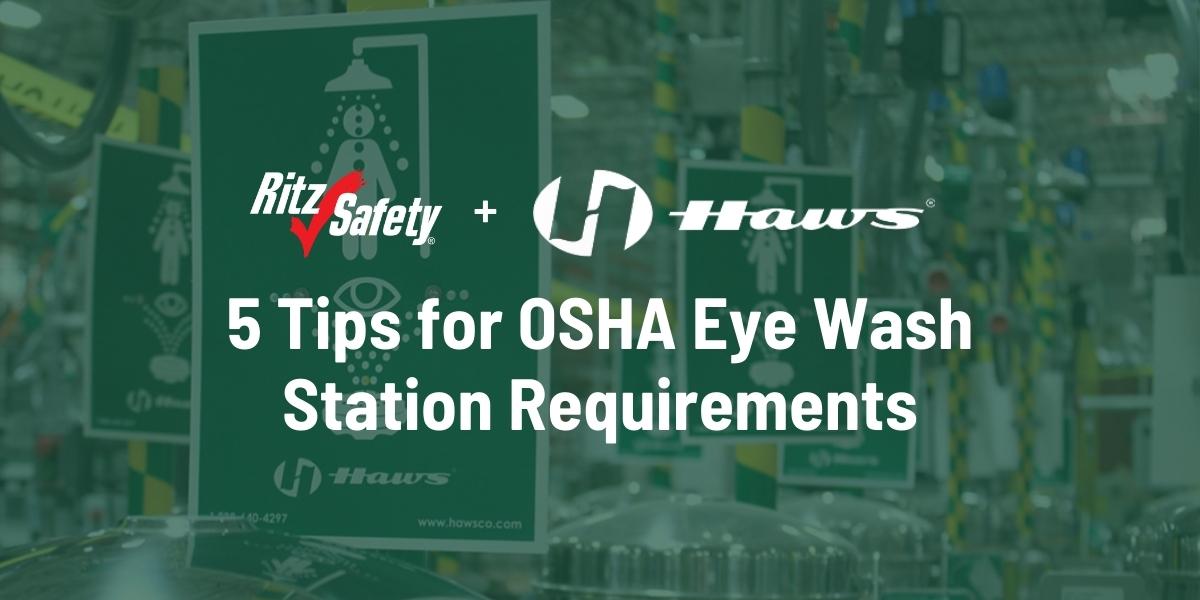
5 Tips for OSHA Eye Wash Station Requirements
According to OSHA, “Where the eyes or body of any person may be exposed to injurious corrosive materials, suitable facilities for quick drenching or flushing of the eyes and body shall be provided within the work area for immediate emergency use.” However, because setting up and maintaining eye and face wash stations is such a small component on many employers' overall safety plan, they can become forgotten about. In fact, Haws® Services conducted a survey and found out that while all sites believed that they were compliant, only 25% of them were actually compliant.
To help make sure you do stay compliant, here are the top 5 tips you can put in place to make sure you exceed the minimum requirements and are ready when an emergency happens!
#1 – Proper Product Specification and Placement
There is no one perfect emergency wash station for all facilities. To choose the equipment that will best work for you, it’s important to critically assess the risks your employees face and then determine the most suitable option that is designed for those hazards. For example, in a chemical plant where liquids are the general risk, an eye/face wash would be the most appropriate. Additionally, due to flow controls and eye irrigation design improvements put in place to meet changes in the Z358.1 Standard revision (2009), choosing from the most recent emergency wash stations is the best option.
Location of your emergency wash station is also just as critical. You should have an appropriate emergency wash station on the same level and within an unobstructed, 10-second walk from the potential hazard, which is roughly 55 feet. Making sure you evaluate the hazards your employees face and where these hazards are is necessary when determining the location and number of wash stations you will need.
#2 – Assure Proper Visibility
Making sure the emergency wash station is clearly visible is just as important as having the correct equipment, as if the employee cannot find the wash station quickly, they won’t be able to either use it at all, or quick enough to minimize injury. Make the wash station visible by using clear signage, proper lighting, and the “safety green” color which, if used consistently, helps an employee recognize where emergency equipment is located.
#3 – Provide Tepid Water
The third tip is to ensure you provide enough tepid water (water that is between 60°F – 100°F) that will allow for at least a full 15-minute drench or irrigation cycle. If the water is too hot or too cold, it may make the injury worse, and the employee may also not use the wash station as it’s not comfortable. To help ensure the water in your wash stations is the correct temperature and stays consistent throughout the entire flow, you can use a paraffin-base thermal actuation and mixing valve within the water chamber.
#4 – Perform Continuous Maintenance & Testing
If you install emergency equipment, but don’t have a process in place to maintain it and keep it working properly, it may not be usable when it’s needed. That’s why it’s important to put in place thorough routine testing. While a quick random activation may seem sufficient enough to ensure it’s working properly, completing a full 15-minute flush as if you were replicating a real-life scenario is much more valuable. This not only allows you to ensure that the unit works for the full flush time and provides enough water for a full 15-minute flow, but it also helps to clear any sediment build-up in the line and minimizes contamination related to inactive water. Be sure to document any routine testing you complete. Documentation of routine testing including location, dates, and performance shows you’re up to date, demonstrates your facility’s diligence in protecting and monitoring each unit, alleviates any questions or concerns related to functionality, and provides instant reference to monitoring all safety equipment performance.
#5 – Create a Robust Safety Culture
You may think installing the safety equipment in your facility is enough, but it’s also important to create a strong culture of safety throughout your company. The hope is that emergency equipment won’t have to be used, but because of that, people may tend to put it out of mind which then may create issues with compliance and the ability to use the equipment properly in an emergency. Creating a cohesive safety program for all employees to continually take part in can help make sure these risks will be understood and help employees become more aware of their and others’ safety.
Do you need emergency wash stations in your facility? Shop all Haws at Ritz Safety, or contact us today!
Original Article Credit: Haws